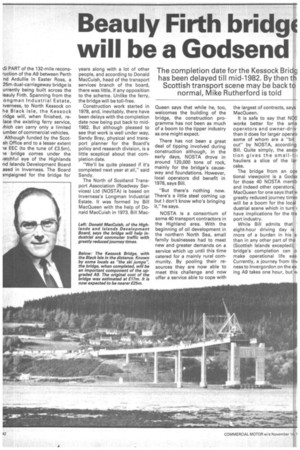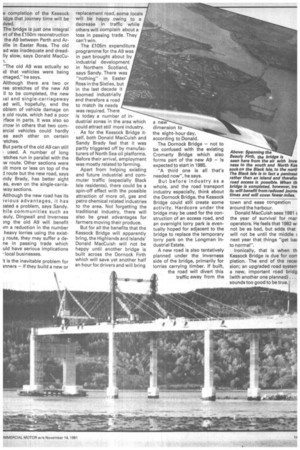Beauly Firth bridge will be a Godsend
Page 84

Page 85

If you've noticed an error in this article please click here to report it so we can fix it.
The completion date for the Kessock Bridg has been delayed till mid-1982. By then th Scottish transport scene may be back to normal, Mike Rutherford is told
kS PART of the 132-mile recons-uction of the A9 between Perth nd Ardullie in Easter Ross, a 25m dual-carriageway bridge is urrently being built across the leauly Firth. Spanning from the ongman Industrial Estate, Iverness, to North Kessock on he Black Isle, the Kessock rridge will, when finished, relace the existing ferry service, thich can carry only a limited umber of commercial vehicles. Although funded by the Scotsh Office and to a lesser extent )e EEC (to the tune of £3.5m), le bridge comes under the ratchful eye of the Highlands nd Islands Development Board ased in Inverness. The Board 3mpaigned for the bridge for
years along with a lot of other people, and according to Donald MacCuish, head of the transport services branch of the board, there was little, if any opposition to the scheme. Unlike the ferry, the bridge will be toll-free.
Construction work started in 1978, and, inevitably, there have been delays with the completion date now being put back to mid1982. But although pleased to see that work is well under way, Sandy Bray, physical and transport planner for the Board's policy and research division, is a little sceptical about that completion date.
"We'll be quite pleased if it's completed next year at ail," said Sandy.
The North of Scotland Transport Association (Roadway Services) Ltd (NOSTA) is based on Inverness's Longman Industrial Estate. It was formed by Bill MacQueen with the help of Donald MacCuish in 1973. Bill Mac Queen says that while he, too, welcomes the building of the bridge, the construction programme has not been as much of a boom to the tipper industry as one might expect.
There has not been a great deal of tipping involved during construction although, in the early days, NOSTA drove in around 120,000 tons of rock, mainly for the bridge's causeway and foundations. However, local operators did benefit in 1978, says Bill.
"But there's nothing now. There's a little steel coming up but I don't know who's bringing it," he says.
NOSTA is a consortium of some 40 transport contractors in the Highland area. With the beginning of oil development in the northern North Sea, small family businesses had to meet new and greater demands on a service which up until this time catered for a mainly rural community. By pooling their resources they are now able to meet this challenge and now offer a service able to cope with the largest of contracts, says MacQueen.
It is safe to say that NOE works better for the sma operators and owner-driv than it does for larger operatc some of whom are a "bit out" by NOSTA, according Bill. Quite simply, the asso( tion gives the small-til hauliers a slice of the lar cake.
The bridge from an OE tional viewpoint is a GodsE for those 40 NOSTA memb and indeed other operators. MacQueen for one says that vk greatly reduced journey time will be a boom for the local dustrial scene which in turn k have implications for the tra port industry.
While Bill admits that eight-hour driving day is more of a burden in his a than in any other part of the (Scottish Islands excepted), • bridge's completion can o make operational life eas Currently, a journey from Inv ness to lnvergordon on the ex ing A9 takes one hour, but vk e completion of the Kessock Age that journey time will be ilved.
The bridge is just one integral irt of the £150m reconstruction the A9 between Perth and Arline in Easter Ross. The old ad was inadequate and dreadIly slow, says Donald MacCu-1.
"The old AS was actually so id that vehicles were being imaged," he says.
Although there are two or ree stretches of the new A9 II to be completed, the new ial and singte7carriageway ad will, hopefully, end the oblem of vehicle damage on e old route, which had a poor rface in parts. It was also so irrow in others that two cornercial vehicles could hardly iss each other on certain -etches.
But parts of the old AS can still
used. A number of long -etches run in parallel with the Arv route. Other sections were iilt more or less on top of the d route but the new road, says Indy Brady, has better sight es, even on the single-carria!way sections.
Although the new road has its )vious advantages, it has 3ated a problem, says Sandy. hile communities such as !auly, Dingwall and Inverness mg the old A9 will benefit )m a reduction in the number heavy lorries using the exist] route, they may suffer a dene in passing trade which uld have serious implications local businesses.
It is the inevitable problem for 3nners — if they build a new or
replacement road, some locals will be happy owing to a decrease in traffic while others will complain about a loss in passing trade. They can't win.
The £105m expenditure programme for the AS was in part brought about by industrial development in Northern Scotland, says Sandy. There was "nothing" in Easter Ross in the Sixties, but in the last decade it boomed industrially and therefore a road to match its needs was required. There is today a number of industrial zones in the area which could attract still more industry.
• As for the Kessock Bridge itself, both Donald MacCuish and Sandy Brady feel that it was partly triggered off by manufacturers of North Sea oil platforms. Before their arrival, employment was mostly related to farming.
Apart from helping existing and future industrial and commuter traffic (especially Black Isle residents), there could be a spin-off effect with the possible attraction of more oil, gas and petro chemical related industries to the area. Not forgetting the traditional industry, there will also be great advantages for farmers moving their produce.
But for all the benefits that the Kessock Bridge will apparently bring, the Highlands and Islands' Donald MacCuish will not be happy until another bridge is built across the Dornock Firth which will save yet another half an hour for drivers and will bring a new dimension to the eight-hour day, according to Donald.
The Dornock Bridge — not to be confused with the existing Cromarty Bridge which also forms part of the new AS — is expected to start in 1985.
"A third one is all that's needed now", he says.
But before industry as a whole, and the road transport industry especially, think about the Dornock Bridge, the Kessock Bridge could still create some activity. Hardcore under the bridge may be used for the construction of an access road, and an overnight lorry park is eventually hoped for adjacent to the bridge to replace the temporary lorry park on the Longman Industrial Estate.
A new road is also tentatively planned under the Inverness side of the bridge, primarily for lorries carrying timber. If built, the road will divert this traffic away from the town and ease congestion around the harbour.
Donald MacCuish sees 1981 E the year of survival for mar operators. He feels that 1982 w not be as bad, but adds that will not be until the middle c next year that things "get bac to normal".
Ironically, that is when th Kessock Bridge is due for conr pletion. The end of the recec sion; an upgraded road systerr a new, important road bridg (with another one planned) ... sounds too good to be true.






















































































